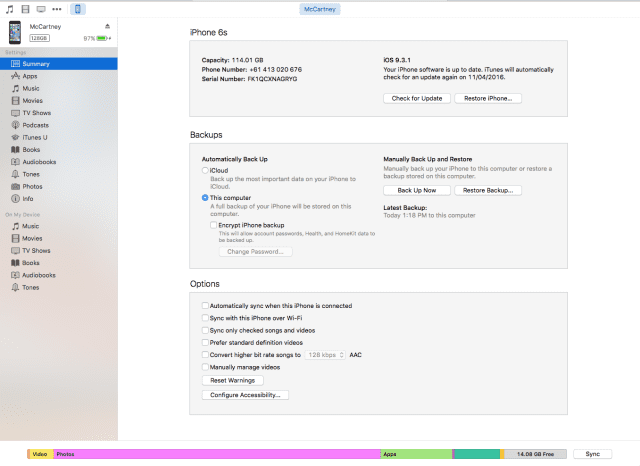A friend put out a cry for help on Facebook recently: “I just emailed myself some videos from my iPhone, because Apple is too stupid to just let you plug your phone in and save them”.
He’d tried using iCloud and he’d tried using Mail Drop and it all just didn’t seem to be working. It should be so simple: plug your phone in and save them. Why is Apple so stupid?
Well, the truth is that Apple isn’t quite that stupid.
You can, in fact, plug your iPhone or iPad into your Mac and save photos and videos wherever you want them. The problem is that what happens (usually) when you plug your iPhone into your Mac is kind of stupid, and the sensible straightforward solution is not the default.
With a few little tweaks, though, you can get photos and videos from your iOS device in exactly the straightforward manner you (and the friend above) might prefer.
First, let’s look at what happens when you plug in an iOS device by default if you haven’t changed any settings.
For a start, iTunes will launch and attempt to sync with your phone.
This isn’t an entirely bad thing, as it means you’ll have a full, local, disk-based backup of the contents of your device in case anything goes wrong.
If you rely on iCloud to back up your device, bear in mind that iCloud backs up “the most important data” — not everything. It’s a good habit to back up your device to a computer every once in a while, even if you do use iCloud backup as well.
At the same time, Photos will launch and attempt to read your device’s Camera Roll and compare the contents against its library to see if there’s anything new.
Again, this is a fine enough thing given the role of Photos as your Mac’s repository of images created by you.
The problem is these two things happening at once. It frankly shouldn’t be possible for two applications on your Mac to attempt to synchronise with the same device at once, but there you go — that is the default behaviour.
Like riding a unicycle and solving the Rubik’s Cube, it’s possible to do these two things at once, but you’re unlikely to do both of them well. Most likely neither will be done as elegantly as if they had been done separately.
So the first thing to do is to change the default behaviour.
First, connect your device. This may be annoying, as the applications arm wrestle over it for a while, but they’ll finish eventually.
Way down here. The option to have iTunes not try to sync your phone automatically when it’s connected ought to be easier to find.
Next, go to iTunes and click on the icon for your device in the upper-left area of the iTunes interface.
If necessary, also click on Summary in the left-hand column to bring up the main control screen for the attached device.
Next, go to the section headed ‘Options’. It may be necessary for you to enlarge the iTunes window or scroll down to find it.
At the top of this section is a tick box: ‘Automatically sync when this iPhone is connected’. Click to deselect that.
You can, of course, still sync manually when you connect your device, but deselecting that option means iTunes won’t immediately try to take control.
Next, open Photos. You’ll probably find you’re already on the Import screen, with your device pictured in icon form at the top of the window.

Or maybe not. Deselect the option to open Photos every time you plug in your iPhone — really, it’s better this way.
Next to it is another tick box: ‘Open Photos for this device’. Deselect that as well. Sure, it’ll be faster once it’s not wrestling with iTunes, but we’ve got a faster and better way still to be seen.
Next, unplug your iPhone. The reason why will be clear shortly.
Open Image Capture from your Mac’s Applications folder (or use a Spotlight search to launch it).
Once Image Capture has opened, then plug in your iPhone.
Had you simply launched Image Capture without unplugging the phone first, the application would not have found the device because iTunes and Photos still owned it.
Shortly, your iPhone should appear in the left-hand column under Devices, and the main window will fill with thumbnails, filenames and info about the contents of your phone’s Camera Roll.
Click on the headings at the top of the columns to decide how to sort things — for example, you might like to have the largest files at the top so that they can be removed from your iPhone to clear up space.

This one, thanks. Of all the options you can have open automatically when you plug your iPhone in, Image Capture is the fastest and best at what it does.
In the bottom-left corner of the Image Capture window, you’ll see a drop-down menu headed ‘Connecting this iPhone opens:’ and a list of suitable applications.
If you don’t see that menu, click on the small reveal arrow at the very bottom of the window and it should appear.
Click on that menu and select Image Capture from the list, so that any time you plug your phone in, this nice quick informative application will launch.
To the right of that drop-down is another, in which you can select an import location for your images.

Where to? The ‘Image Capture > Import to:’ menu is an amazingly powerful thing and well worth taking some time getting to know. You can even use Automator to create your own plug-ins for this menu.
Remember, of course, that you can simply drag individual files straight from the Image Capture window to any location you choose on an ad hoc basis.
However, if you want to set up a regular workflow, you can choose an application or a folder in the Finder to which images will be saved.
If you select a Finder location (say, your Pictures folder) then another option appears in this menu: ‘Make subfolders per camera’.
This is new in El Capitan, and means you can have separate folders for each device you connect — handy if the family has multiple iPhones and iPads.
The other great bonus with using Image Capture instead of Photos to import images from your iPhone is feedback — you have a far better idea of where you’re up to with Image Capture, while Photos can often look like it’s just hung while importing a large video file.
And if you still want to have your images available in Photos, no problem — just drag and drop. It’s actually faster this way than importing directly into Photos.

![[Interview] How Does a Used Galaxy Device Become a Key Part](https://loginby.com/itnews/wp-content/uploads/2025/03/1743244674_Interview-How-Does-a-Used-Galaxy-Device-Become-a-Key-238x178.jpg)





